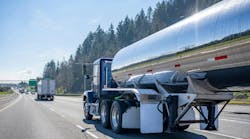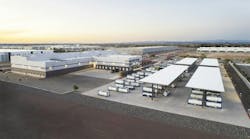THE way Bob Heinisch sees it, a driver's primary job really isn't driving a truck. That's a skill the driver has. The real skill a driver needs is the ability to deliver products safely for customers. That's the core of the business.
“Just getting to and from the loading rack to the ultimate location is the easy part of the job,” said Heinisch, vice-president of safety for Eagle Transport Corp. “It takes a special, highly intelligent individual to be a driver. They are faced with perils every day. All of our petroleum trucks run 24/7, 365 days a year. We operate two to three shifts per truck, and all operations are within a 50-mile radius of the petroleum terminal. They're always in congested urban traffic.”
The issue of tight delivery sites was a key element of the panel discussion during the National Tank Truck Carriers annual Tank Truck Safety & Security Council Seminar April 5-7 in Austin, Texas. Entitled “Safe Deliveries at Service Stations,” the session featured Heinisch, Florida Rock & Tank Lines vice-president of safety Jim Anderson, and Kenan Advantage Group vice-president of safety Becky Perlaky.
Heinisch said traffic at the delivery site creates one of the greatest perils. Many obstacles are built into the site design (vacuums, pay phones, fuel-dispensing pumps, tire pumps, dumpster pads) in close proximity to the delivery pad.
“All of you fuel your own cars,” he said. “If you go to a high-volume station with 12 to 24 pumps, I'm sure you've been there at times when there has been a sale on gas and all 24 pumps are full, and 24 cars are waiting. Those people are more interested in getting gas in their car or running in for a pack of cigarettes and a soda than they are paying attention to where they go. That's the peril all of us have as truckers — looking out for non-professional drivers.
“At Eagle, all locations first of all are geofenced in the GPS system so the driver knows where to go. Through experience, we know the high-volume traffic and sales times, and whenever possible we limit deliveries to off-peak hours.”
Perlaky: “We made well over two million deliveries. Out of those, we had 43 situations where a car backed into, or turned into, or struck our vehicle. They don't see bumpers on trailers or the front of a tractor. Four of those cars actually hit our cones, where we had a substantial spill. Sometimes it seems like they're using those cones as a target. In the Midwest we don't have big convenience stores. We have small ones where it's difficult to enter and exit. It's ever changing. They start selling all kinds of things at stations — like firewood — that may get into a driver's way. We see lot of that in the Midwest.”
Anderson: “We've seen an increase in the trend. I believe it's distracted driving. Motorists pay even less attention to the area around them. In retail sites, it can be like a zoo. We're putting measures into place to combat that.”
Many of the sites don't seem to be designed with deliveries from large tractor-trailers in mind, according to the panelists. Site footprints are very small. Traffic patterns, entrances, and exits are designed for passenger vehicles and customer convenience, so they often do not provide adequate space for 60-foot-plus trucks.
Carriers often provide drivers with site plans that include directions for entering the site, spotting for deliveries, and exiting the site. The plans will often provide warnings about any specific obstacles that exist.
“Many of these older stores, and a lot of the newer ones, are designed for four-wheeled cars, not necessarily tractors and trailers, so they have curbs,” Heinisch said. “We have a tremendous tire expense with curbing tires, getting in and out of locations. That's just another of the perils. When you curb a tire, it may not fail today, but it could tomorrow. Then you have a delay in the delivery and the driver trying to make up time. Then you have a lack of focus and may have a safety issue.”
Heinisch said drivers receive training in spatial awareness, and are told to avoid backing when possible and to get out and look (GOAL) prior to backing. He said Eagle has safety cones and straps to delineate its drivers' risk area to keep them from being struck by vehicles.
Anderson said Florida Rock & Tank Lines has had great success with Strapguard, which pulls out from the back of the truck and attaches to the cones, providing a four-foot-high barrier.
“We've added and retrofitted them to trailers,” he said. “Drivers tell us they have to take the cone out of there anyway, so they can take the strap out at the same time. It's not additional work. They don't have to take another device out there. It's a fluid motion. Having that horizontal barrier really presents a different image visually to pedestrians and motorists. Vehicles come from the front or back and not directly into the truck, so it blocks the area that vehicles typically come from.”
Product mixing
It has been found that multiple-compartment trailers, loaded with multiple products, can contribute to the mixing of product in the customer's tanks. Three solutions found to be common among carriers are: tank configuration solutions, product ID markers, and distillate markers.
Most carriers have provided drivers with some sort of tank-configuration document or have added tank configuration to their technology. This assists the drivers by allowing them to document their loading configuration for retrieval at the delivery site.
Many carriers have installed product ID markers on their delivery heads to assist drivers with this issue. Many carriers also have added tools (yellow/green traffic cones and/or dust cap tags) to help specifically identify compartments loaded with distillates.
Delivery sites do not always provide the best methods for identifying tanks, Heinisch said. Accurate tank identification is critical to ensure quality control of motor fuel and heating oil. Many carriers have created programs to assist drivers in identifying the tanks.
Eagle has a program called “Match Two or Call.” A decal says, “If you cannot match two from each column to verify the right product to the right customer tank, call your dispatcher for guidance.” The first column includes: driver report, bill of lading, pickup order or tank configuration worksheet, and distillate loading procedure. The second column includes: customer information sheet, product ID bands, product ID tags, painted, stenciled product ID name, and color codes.
Florida Rock developed a STOP-THINK-ACT decal with bullet points listing key steps: always stay focused; before loading, verify compartment is empty; record product type and gallons on FRTL freight bill; set product markers; verify delivery location; verify tank identification; verify capacity, never exceed 90%; check paperwork to see if correct compartment hooked up to tank; trace hose from compartment to tank; stand by valves in case of emergency; and bucket drain each compartment before leaving.
The addition of ethanol to the product stream has greatly increased the urgency of preventing water contamination, Heinisch said.
“There's a 10% blend in all states I operate in,” he said. “Ethanol absorbs water. So if you have any water in a petroleum tank that you're delivering ethanol-blended fuel in, you run the risk of absorbing water and then separating and then you have water and ethanol at the bottom of the tank and gasoline on the top. All dispensing pumps are at the bottom of the tank. If you get phase separation because the driver failed to check for water or there was water added to the tank when it was loaded, then you risk multiple vehicle claims. I've had as many as 30 on one delivery from people fueling at high-volume stations getting phase-separated fuel. That's a big cost and a big worry to us.”
To prevent water contamination, carriers require drivers to use water detecting paste, when stick gauging tanks, before and after delivery to each tank. Drivers are instructed to contact their managers/dispatchers if any water is found.
“Contamination is a major cost, especially when you get into vehicle damage, engine damage, fuel injectors,” Perlaky said. “Something I face on a continuing basis with our operations and dispatch is how many carriers are out there transporting gasoline and K-1 (kerosene) on the same load. We would encourage you not to do that. While you can replace cars if there's engine damage, you can't replace lives if there are house fires. And K-1 that's sold contaminated with gas can result in house fires. We know it's still being done because when we refuse to do it, the customers call another carrier.”
Heinisch said loading configuration tools include space for drivers to enter the number of gallons loaded in each compartment. Accurate tank identification is also an essential key in preventing spills. Customer information/route sheets include tank sizes and tank calibration charts. Drivers stick gauge tanks and check their readings against tank calibration charts for fit. Tanks are customarily not allowed to be filled beyond 90% of their capacity.
“One of my greatest fears is the release of petroleum products, because a five-gallon spill can easily be $5,000, $10,000, or $20,000 worth of response costs,” Anderson said. “If you get product on soil, it's automatically assumed it goes through the ground water. It's just a real pain. If anything gets into the drain, you have to chase for miles sometimes. It's something we train our drivers to avoid.” ♦
<< View more NTTC seminar coverage
View more NTTC seminar coverage >>














